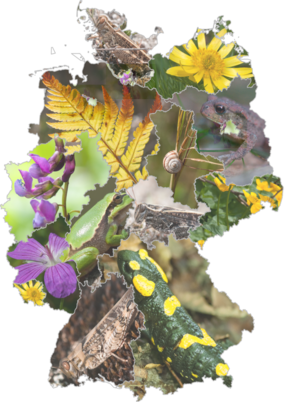Research group Biodiversity Change & Citizen Science
sMon - Analysing trends in German species data

| Contacts | Partners | Funding | Publications |
Short description
Biodiversity change is one of the biggest challenges facing mankind. To understand the complex patterns of this change, ecologists are dependent on the availability of monitoring data and the development of statistical tools to analyse these data. For most organisms, the available data that can inform on past trends are a heterogeneous mix of data types of varying accessibility.
In the Biodiversity Change & Citizen Science working group, we compile community datasets from heterogeneous data sources from agencies, natural history societies and citizen science projects on various taxa and develop and apply statistical methods to analyze them. Our questions are focused on species long-term population trends and community turnover; the geographic patterns of change and links to environmental variation, and the predictive ability of response and effect traits, and species co-occurrence patterns. Moreover, we use simulation models to assess how much (and what type of) data are needed to detect population and community changes over time as well as the ability of different analytical approaches to account for the different sorts of biases within unstructured biodiversity data.
Methodological focus
• Occupancy-detection models
• Point pattern models
• Frescalo models
• Hierarchical (Bayesian) mixed models with spatio-temporal autocorrelation
sMon is a Synthesis Project of the German Centre for Integrative Biodiversity Research (iDiv) Halle-Jena-Leipzig. We aim at combining and harmonizing exemplary datasets of different taxa and habitats and to evaluate the potentials and limits for analyzing changes in the state of biodiversity in Germany. Based on these insights, we will derive perspective for future biodiversity monitoring programs in Germany.
Structure of the project
WP: PlantsWP: Dragonflies/Damselflies
WP: Amphibians
WP: Beetles
Website: https://www.idiv.de/en/smon.html
Aims and scope
- Screening, harmonizing and integrating heterogeneous time series data from different sources and from exemplary species groups
- Development of statistical methods to derive statistically sound trends for species from these taxa based on this heterogeneous data
- Assisting in the identification of statistical cornerstones for the collection of biodiversity data within an efficient future biodiversity monitoring scheme in Germany
Contacts
Partners
iDiv Consortium Partners and external science partners:
- Prof. Helge Bruelheide, MLU Halle
- Prof. Florian Jansen, Universität Rostock
- Dr. Marten Winter, Universität Leipzig
- Prof. Klaus Henle, UFZ
- Prof. Jens Dauber, Thünen-Institut
- Prof. Katrin Boehning-Gaese, Senckenberg-Gesellschaft
- Biological Records Centre (UK)
- Dr. Nick Isaac, Centre for Ecology & Hydrology (UK) / Biological Records Centre (UK)
- Prof Bob O’Hara, Norwegian University of Science and Technology
sMon network partners:
- Bundesamt für Naturschutz Deutschland (BfN)
- Landesamt für Umwelt, Landwirtschaft und Geologie Sachsen
- Thüringer Landesamt für Umwelt, Bergbau und Naturschutz
- Landesamt für Umweltschutz Sachsen-Anhalt
- Niedersächsisches Ministerium für Umwelt, Energie, Bauen und Klimaschutz
- Hessisches Landesamt für Naturschutz, Umwelt und Geologie
- Landesamt für Umwelt- und Arbeitsschutz Saarland
- Landesamt für Natur, Umwelt und Verbraucherschutz Nordrhein-Westfalen
- Landesamt für Umweltschutz Bayern
- Landesamt für Umwelt Baden-Württemberg
- Behörde für Umwelt und Energie Hamburg
- Senatsverwaltung für Umwelt, Verkehr und Klimaschutz Berlin
- Landesamt für Umwelt, Naturschutz und Geologie Mecklenburg-Vorpommern
- Landesamt für Umwelt Brandenburg
- Landesamt für Landwirtschaft, Umwelt und ländliche Räume
- Landesamt für Umwelt Rheinland-Pfalz
- Ulrich Schulte, Deutsche Gesellschaft für Herpetologie und Terrarienkunde (DGHT)
- Klaus-Jürgen Conze, Prof Frank Suhling, Gesellschaft deutschsprachiger Odonatologen (GdO)
- Dr. Claudia Drees, Ortwin Bleich, Stefan Gürlich, GAC / ColKat/ Entomofauna Germanica
Funding
sMon is funded through the iDiv Flexpool.
Publications (selection)
Jansen F., Bonn A., Bowler D.E., Bruelheide H., Eichenberg, D. (2019): Moderately common plants show highest relative losses. Conservation Letters: doi: 10.1111/conl.12674
Bruelheide, H., Jansen, F., Jandt, U., Bernhard-Römermann, M., Bonn, A., Bowler, D., Dengler, J., Eichenberg, D., Grescho, V., Harter, D., Jugelt, M., Kellner, S., Ludwig, M., Wesche, K. & Lütt, S. (in review) Using incomplete floristic monitoring data from habitat mapping programmes to detect species trends.
Eichenberg, D., Bowler, D., Bruelheide, H., Jansen, F., Jandt, U., Bernhard-Römermann, M., Dengler, J., Harter, D., Henle, K., Hofmann, S., Isaac, N.J., Kamp, J., König-Ries, B., Kraemer, R., Ludwig, M., Lueg, H., Ronnenberg, K., Schiffers, K.H., Schulte, U., Sperle, J., Stab, S., Wirth, C. & Bonn, A. (in review) Langfristige Biodiversitätsveränderungen in Deutschland erkennen - Mit Hilfe der Vergangenheit in die Zukunft schauen.
Kühl, H.S., Bowler, D., Bruelheide, H., Eichenberg, D., Eisenhauer, N., Guerra, C., Henle, K., Isaac, N.J.B., Jansen, F., König-Ries, B., Pe’er, G., Richter, A., Voigt, M., Wirth, C. & Bonn, A. (in prep) Effective biodiversity monitoring needs integration.
